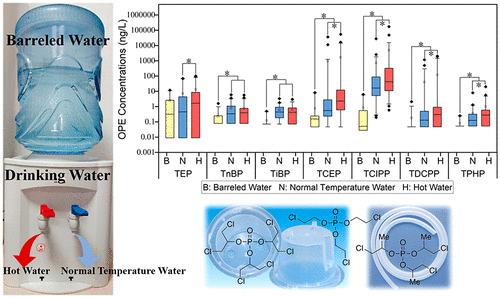当前位置:
X-MOL 学术
›
Environ. Sci. Technol. Lett.
›
论文详情
Our official English website, www.x-mol.net, welcomes your
feedback! (Note: you will need to create a separate account there.)
Increased Human Exposure to Organophosphate Esters via Ingestion of Drinking Water from Water Dispensers: Sources, Influencing Factors, and Exposure Assessment
Environmental Science & Technology Letters ( IF 8.9 ) Pub Date : 2021-09-01 , DOI: 10.1021/acs.estlett.1c00592 Minmin Hou 1, 2 , Yali Shi 1, 2, 3 , Guangshui Na 4 , Zongshan Zhao 5 , Yaqi Cai 1, 2, 3
Environmental Science & Technology Letters ( IF 8.9 ) Pub Date : 2021-09-01 , DOI: 10.1021/acs.estlett.1c00592 Minmin Hou 1, 2 , Yali Shi 1, 2, 3 , Guangshui Na 4 , Zongshan Zhao 5 , Yaqi Cai 1, 2, 3
Affiliation

|
Little is known about the presence of organophosphate esters (OPEs) in drinking water from water dispensers, which are popular in China. In this study, 22 OPEs were measured in barreled water (BW), normal-temperature water (NTW), and hot water (HW) collected from 53 water dispensers. Eight OPEs were frequently detected, with total concentrations (median) increasing by 23- and 52-fold in NTW and HW, respectively, compared with BW. Six OPEs exhibited significantly higher levels in NTW and HW than in BW. The gradually increased levels of several OPEs in water after it had been stored in plastic tanks, coupled with the frequent detection of seven OPEs in silicone tubes, demonstrated that water tanks and silicone tubes are sources of release of OPEs. OPEs in silicone tubes may be due to adsorption from air and dust. Simulation experiments suggested that the amount of OPEs released from sources depends upon the water temperature and the time of contact between the water and sources. The estimated daily intake of OPEs via drinking water from water dispensers was 39 times that via BW, indicating that water dispensers increase the risk of human exposure to OPEs. The higher exposure of Chinese adults to TCIPP via drinking water than via inhalation and dust ingestion needs to be studied.
更新日期:2021-10-12











































 京公网安备 11010802027423号
京公网安备 11010802027423号